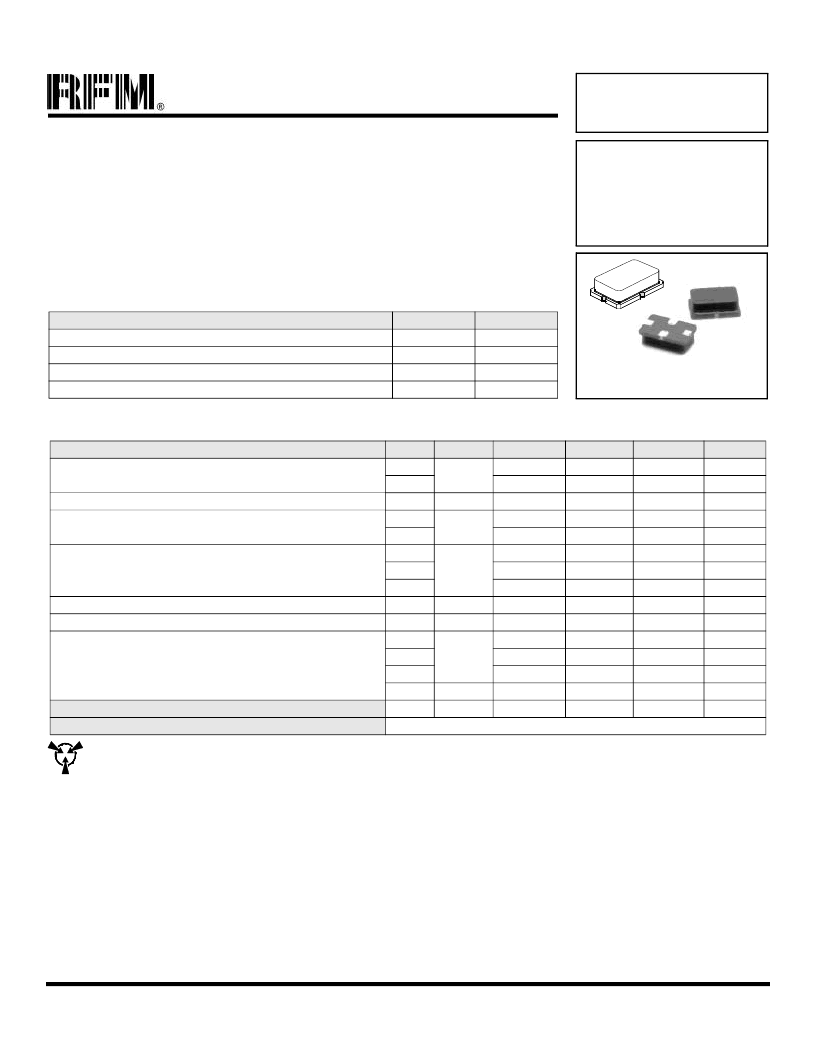- 您現(xiàn)在的位置:買賣IC網(wǎng) > PDF目錄373300 > RO2075 Analog IC PDF資料下載
參數(shù)資料
| 型號: | RO2075 |
| 英文描述: | Analog IC |
| 中文描述: | 模擬IC |
| 文件頁數(shù): | 1/2頁 |
| 文件大小: | 173K |
| 代理商: | RO2075 |

RF Monolithics, Inc.
RFM Europe
1999 by RF Monolithics, Inc. The stylized RFM logo are registered trademarks of RF Monolithics, Inc.
Phone: (972) 233-2903
Phone: 44 1963 251383
Fax: (972) 387-9148
Fax: 44 1963 251510
E-mail: info@rfm.com
http://www.rfm.com
RO2073A-6-102899
Page 1 of 2
Electrical Characteristics
Characteristic
Absolute Frequency
Tolerance from 315.000 MHz
Sym
f
C
f
C
IL
Q
U
Q
L
T
O
f
O
FTC
|f
A
|
Notes
Minimum
314.950
Typical
Maximum
315.050
±50
2.2
Units
MHz
kHz
dB
Center Frequency (+25 °C)
2,3,4,5
Insertion Loss
Quality Factor
2,5,6
1.3
Unloaded Q
50
Loaded Q
Turnover Temperature
Turnover Frequency
Frequency Temperature Coefficient
Absolute Value during the First Year
5,6,7
15,300
2,100
25
f
C
0.032
≤
10
Temperature Stability
6,7,8
10
40
°C
ppm/°C
2
ppm/yr
M
μH
fF
pF
nH
Frequency Aging
DC Insulation Resistance between Any Two Terminals
RF Equivalent RLC Model
1
5
1.0
Motional Resistance
Motional Inductance
Motional Capacitance
Shunt Static Capacitance
R
M
L
M
C
M
C
O
L
TEST
5, 7, 9
16
29
127.450
2.00299
2.6
5, 6, 9
2, 7
2.0
2.3
110
Test Fixture Shunt Inductance
Lid Symbolization (in addition to Lot and/or Date Codes)
164
Ideal for 315.0 MHz Automotive-Keyless-Entry Transmitters
Very Low Series Resistance
Quartz Stability
Surface-Mount Ceramic Case with 21 mm
2
Footprint
The RO2073A-6 is a true one-port, surface-acoustic-wave (SAW) resonator in a surface-mount, ceramic
case. It provides reliable, fundamental-mode, quartz frequency stabilization of fixed-frequency transmitters
operating at 315.0 MHz. This SAW is designed for AM transmitters in automotive-keyless-entry applications
operating in the USA under FCC Part 15, in Canada under DoC RSS-210, and in Italy.
Absolute Maximum Ratings
Rating
Value
+0
±30
-40 to +85
+250
Units
dBm
VDC
°C
°C
CW RF Power Dissipation (See: Typical Test Circuit)
DC voltage Between Terminals
Case Temperature
Soldering Temperature
315.0 MHz
SAW
Resonator
RO2073A-6
CAUTION: Electrostatic Sensitive Device. Observe precautions for handling.
Notes:
1.
Frequency aging is the change in f
C
with time and is specified at +65°C or less.
Aging may exceed the specification for prolonged temperatures above +65°C.
Typically, aging is greatest the first year after manufacture, decreasing in subse-
quent years.
The center frequency, f
C
, is measured at the minimum insertion loss point,
IL
MIN
, with the resonator in the 50
test system (VSWR
≤
1.2:1). The shunt
inductance, L
TEST
, is tuned for parallel resonance with C
O
at f
C
. Typically, f
OS-
CILLATOR
or f
TRANSMITTER
is approximately equal to the resonator f
C
.
One or more of the following United States patents apply: 4,454,488 and
4,616,197.
Typically, equipment utilizing this device requires emissions testing and govern-
ment approval, which is the responsibility of the equipment manufacturer.
Unless noted otherwise, case temperature T
C
= +25°C±2°C.
The design, manufacturing process, and specifications of this device are subject
to change without notice.
Derived mathematically from one or more of the following directly measured
parameters: f
C
, IL, 3 dB bandwidth, f
C
versus T
C
, and C
O
.
2.
3.
4.
5.
6.
7.
8.
Turnover temperature, T
O
, is the temperature of maximum (or turnover) fre-
quency, f
O
. The nominal frequency at any case temperature, T
C
, may be calcu-
lated from: f = f
O
[1 - FTC (T
O
-T
C
)
2
]. Typically
oscillator
T
O
is approximately
equal to the specified
resonator
T
O
.
This equivalent RLC model approximates resonator performance near the reso-
nant frequency and is provided for reference only. The capacitance C
O
is the
static (nonmotional) capacitance between the two terminals measured at low
frequency (10 MHz) with a capacitance meter. The measurement includes para-
sitic capacitance with "NC” pads unconnected. Case parasitic capacitance is
approximately 0.05 pF. Transducer parallel capacitance can by calculated as:
C
P
≈
C
O
- 0.05 pF.
9.
SM-2 Case
相關(guān)PDF資料 |
PDF描述 |
|---|---|
| RO2071 | Analog IC |
| RO2073 | Analog IC |
| RO2073A-1 | Analog IC |
| RO2073A-4 | Analog IC |
| RO2081A | Analog IC |
相關(guān)代理商/技術(shù)參數(shù) |
參數(shù)描述 |
|---|---|
| RO2081A | 制造商:RFM 制造商全稱:RF Monolithics, Inc 功能描述:325.05 MHz SAW Resonator |
| RO21 | 功能描述:ACCY SUB MISC RW 21IN RoHS:是 類別:RF/IF 和 RFID >> RF配件 系列:* 標(biāo)準(zhǔn)包裝:1 系列:* |
| RO2101 | 制造商:RF Monolithics (RFM) 功能描述:RESONATOR 433.92MHZ TH 3TO-39 - Rail/Tube |
| RO2101A | 制造商:RFM 制造商全稱:RF Monolithics, Inc 功能描述:433.92 MHz SAW Resonator |
| RO2101A-10 | 制造商:RFM 制造商全稱:RF Monolithics, Inc 功能描述:433.92 MHz SAW Resonator |
發(fā)布緊急采購,3分鐘左右您將得到回復(fù)。